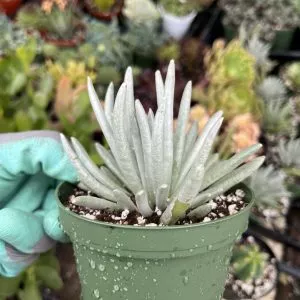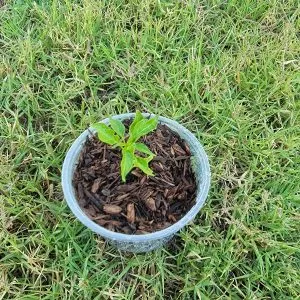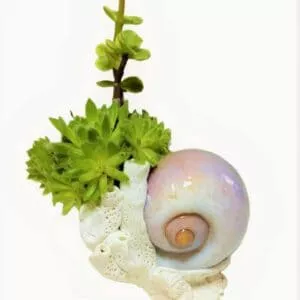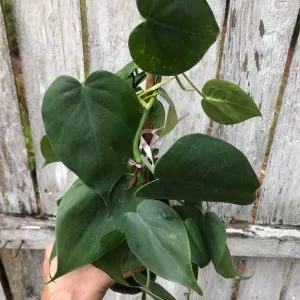No products in the cart.
Table of Contents
Chlorophytum comosum or commonly known as spider plants are fast-growing plants with those cute babies hanging around them like their tiny little spidey. It is such a welcome sight when you own one of them.
The babies are already a major edge to their great foliage, hanging around the mother-spidey plant like a little sucker teaser. Not to mention that these baby spider plants hanging, ALREADY indicate super easy propagation.
What is a Spider Plant?
Chlorophytum comosum is a slender plant that extends from a basal rosette. When baby spider plants grow, the leaves can reach up to 18 inches in length. Two popular varieties that they’re known the Chlorophytum comosum ‘Vittatum’ and ‘Variegatum.’
The Vittatum has bolder white stripes running down the center of the leaf with dark green margins. The Variegatum has a green line with silvery-white margins. In spring, this indoor plant blooms white flowers.
New plantlets form from the stem as it tries to self-propagate. You’ll notice that it has a dense yet white tuberous root and originates from South Africa. This is because the plant can survive periods of drought as it stores water.
The best part is that you can use different spider plant propagation methods. But a bit more on this later.
Spider Plant Babies Care
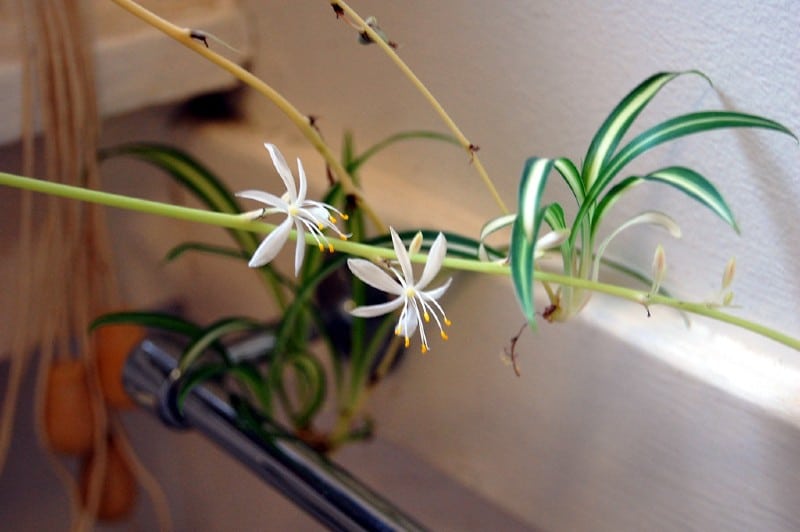
Maybe you received a baby spider plant or just bought a new one from your local nursery. Then these care tips are just right for you.
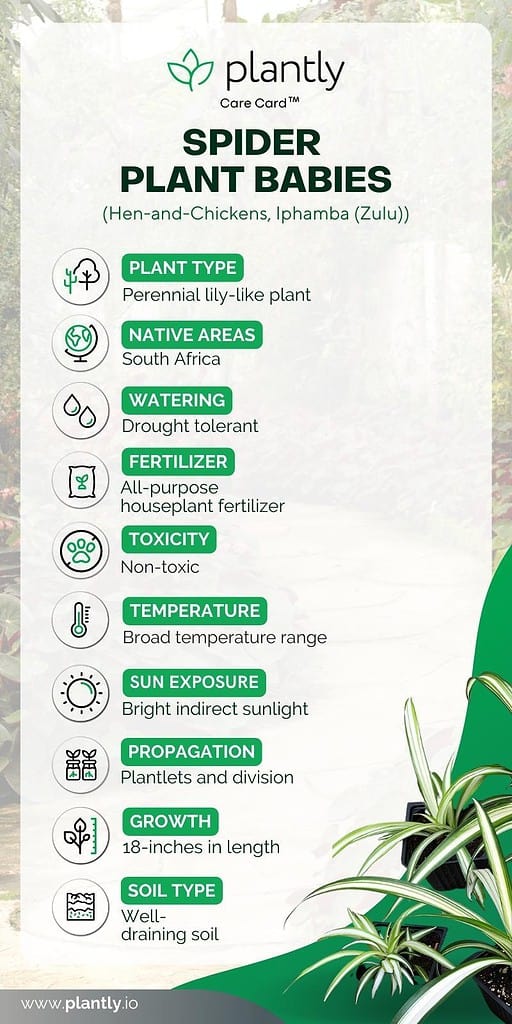
Recommended Potting Mix for Baby Spider Plants
Okay, you received some spider plants, and the mother plant has spider plant spiderettes. You want to propagate them; it helps to know what type of soil these indoor plants need to thrive.
Well, one thing is certain tiny spider plants survive in most potting soil types. Yet, they appreciate adequate drainage using perlite or some sand.
The problem is an overwatered spider plant baby can get root rot.
The Best Optimal Lighting Conditions
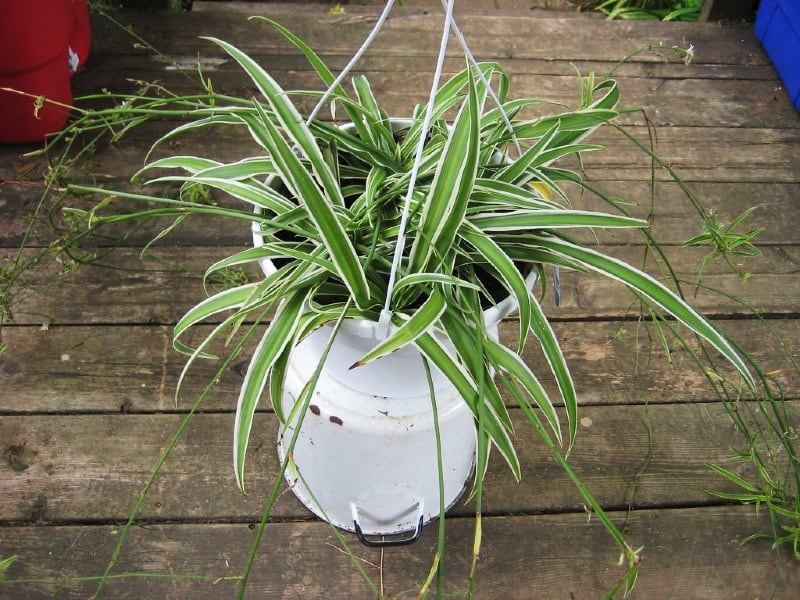
Spider plants love bright indirect light but can grow as outdoor plants in partial shade, tolerating some direct sun.
Still, depending on the climate, you can place them in full sun but can start showing signs of scorched brown-tipped leaves.
So, if grown as a houseplant, we recommend not placing them on a window sill that receives intense light.
Watering Your Spider Babies Plant
Yes, your airplane plant is another exciting name for this long-stem greenery that loves a good gulp of water. You can water your new babies once a week in the growing month.
During winter, they only need water once every three weeks. As the roots are fleshy, it stores water naturally, and if you forget to water them for a short while, they will not die, yeah!
But if you are uncertain when to water, you can do the finger test in the potting medium. If the ground feels moist, then leave it be. Still, if it feels dry, then give them some water to make sure they remain happy.
Temperature & Humidity

The remarkable thing about this little plant when small, it can thrive in different temperatures. The temperature can reach as low as 35°F (2°C) or as high as 90°F (32°C), and they still feel comfortable.
Another fantastic thing is these plants can handle fluctuating seasonal temperatures well. But, of course, the same applies to humidity, and as an indoor plant, they love the bathroom and kitchen.
Still, if you live in low humidity, it helps to give them a misting once a week in the dry summer. Even if the climate is excellent, a quick mist keeps the leaves flourishing.
Feeding Spider Plants
When it comes to spider plant care, it is a natural going plant needing no special fertilizers. You can use a diluted feed of all-purpose houseplant fertilizer. But please try to prevent over-feeding as it can turn the long stems and leaves brown.
The best time to feed your spider plants is in the growing season.
Propagate Spider Plant Babies Using These Methods
Great you have a mother plant and want to propagate spider plant babies. You have arrived at the right place. But before you start, it helps to know when to do this.
The fact is compared to other indoor plants; you can do this at any time of the year. But we recommend doing it in spring or summer as it is actively growing.
Another notable thing is you will know when to do this when the baby spider plants have roots forming underneath. As mentioned, there are three methods for rooting spider plant babies.
You can use the cuttings, and grow them from division and seeds. Now, to know what spider plant babies are, the offshoots are called plantlets or spiderettes growing from your main plant.
The spiderettes flower in summer and baby plants grow from them, and if not pollinated, you get plantlets. But pollination does not occur; you get seeds instead of plantlets.
So you can root the plantless in the soil while attached to the mother plant. Or you can cut them to root in water or a propagation box.
-
$70.00Sold By: Andy Nursery
$75.00In stock
Kishu Mandarin Grafted Tree 3 Feet Tall. Free Shipping
Sold By: Andy Nursery -
$10.00Sold By: Cacti and Exotica
In stock
Senecio Scaposus
Rated 4.98 out of 5 based on 59 customer ratings00Sold By: Cacti and Exotica -
Free Shipping$156.04Sold By: BONSAI WORLD LLC
Only 1 left in stock
Ficus Kaneshiro Bonsai Tree (ficus microcarpa ‘kaneshiro’)
Only 1 available and it’s in 1 people’s basketSold By: BONSAI WORLD LLC
Spider Plant Cuttings
Once the baby plant grows a root formation, you can take cuttings from them. If there are no roots, you notice tiny nubs and best to wait.
When they are mature, you can remove them from the host plant by cutting them off. You can cut them as close to the plantlets as possible to prevent the stem from sticking out.
Now, prune the long stem back of the mother plant as nothing grows on it again. Then, you can root your babies, placing them in water for the roots to grow.
Still, as the babies are vulnerable, they can rot or go into shock when you transplant them. But before you place them in water, pinch off the leaves growing at the base.
Fill a transparent vase with enough water to cover the roots.
Propagating in a Chamber
Using this method helps to keep the humidity high to root faster. Or you can create a mini greenhouse planting the babies in a small pot with a plastic bag over them.
Here we recommend using a light mix of peat moss, vermiculite, and perlite or pumice. Before planting your cuttings, you can dip them in a rooting hormone for them to sprout.
Propagating Spider Plants With Babies Attached

Using this method is excellent as your babies do not go into transplant shock and are stronger. Still, it is a bit tricky as sometimes they do not root.
Take some regular potting mix or the same one we used previously and place it in a container. Place the potting medium next to the host plant and stick the roots of the plantlet into the ground.
As soon as several roots grow, you can pot them in general soil and water them well. Make sure to remove the excess water as well.
Division
The best option if your spider plant has no offshoots is using division. The important thing is it needs to have two clumps growing inside the pot to split them apart. If your plat is root-bound, use a sterile knife to divide them.
Growth Zone

You can grow it as a perennial outdoor plant if you live in zones 9-11. In colder zones, place them indoors, reciprocating the environment they thrive in with a little help with the humidity.
Potting Your Spider Plants
The spider plant enjoys becoming semi-rooted and grows in smaller house plants. When you notice the white roots protruding out of the soil or the drainage holes, it is time to give it a new home. Provide your plant with a bigger pot and some fresh dirt to keep it happy.
Final Thought
Regardless of how you grow your spider plant, Plantly is just here to guide you on how to help your plant thrive in the best condition ever. So that you know, the spider plant is one of the top easy houseplants you can grow indoors.
Frequently Asked Questions
You can remove the plantlets from the mother plants once they have a root system and place them in a vase. Only cover the roots with water and remove any leaves around them to prevent them from rotting.
You can leave the babies on the mother plant as they may grow spiderettes of their own. But if you do this, we recommend providing your plant with additional feeding.
If you want to propagate spider plants removing the babies once it has a root system is the best way. Or you can leave it on the host plant and place the babies in their tiny pot with moist soil. Then, once the roots grow and settle, you can remove the baby from the mother plant.
Sometimes the spider plantlets come off quickly when disturbed, and you do not need to cut them. We recommend if you want more houseplants, you can cut the babies as close to the top as possible without leaving multiple runners.
When you expose your spider plants to more light in indirect sunlight, they produce babies. You need not have a green thumb to care for them as they are one of the easiest houseplants to care for. Please provide them with direct sunlight in the morning with afternoon shade and keep the soil slightly moist.
Nothing will happen when you leave the spider plantlets on the mother plant. Ensure that the stems are healthy and not dried out. The little babies get their nutrients and water through the runners. They will eventually have their own babies that will trail down.
Whether you want to buy, sell, or simply reach out to other plant enthusiasts, Plantly is the right place to be!
-
Free Shipping$20.00Sold By: Blessed Family Farm
In stock
Live Cayenne Pepper Plant
Rated 4.82 out of 5 based on 22 customer ratings03Sold By: Blessed Family Farm -
Free Shipping$24.99Sold By: Gar-Zen Botanical Design
In stock (can be backordered)
Succulent Seashell Planter Ships Free.
Rated 4.86 out of 5 based on 49 customer ratings00Sold By: Gar-Zen Botanical Design -
$79.00Sold By: The Magic Walnut Plant Shoppe
$93.00In stock
Philodendron Florida Beauty Variegated
Rated 4.17 out of 5 based on 294 customer ratings00Sold By: The Magic Walnut Plant Shoppe -
$12.95Sold By: SunSoul Plants
$22.95In stock
Philodendron Scandens plant in 4″ pot, Green Philodendron, Heartleaf Philodendron
Only 2 available and it’s in 1 people’s basketRated 4.87 out of 5 based on 98 customer ratings00Sold By: SunSoul Plants

